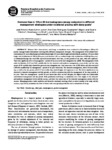Please use this identifier to cite or link to this item:
http://www.alice.cnptia.embrapa.br/alice/handle/doc/956441| Title: | Biomass flow in Tifton-85 bermudagrass canopy subjected to different management strategies under rotational grazing with dairy goats. |
| Authors: | CUTRIM JÚNIOR, J. A. A.  CAVALCANTE, A. C. R.   CÂNDIDO, M. J. D.   SILVA, G. L.   OLIVEIRA, L. E. V.   VASCONCELOS, E. C. G.   MESQUITA, T. M. O.   |
| Affiliation: | José Antonio Alves Cutrim Junior, Pós-graduação - Universidade Federal do Ceará (UFC) - Fortaleza; Instituto Federal Maranhão (IFMA); ANA CLARA RODRIGUES CAVALCANTE, CNPC; Magno José Duarte Cândido, UFC - Fortaleza, CE; Gutenberg Lira Silva, Graduação - Universidade Estadual Vale do Acaraú (UVA) - Sobral, CE; Luiza Elvira Vieira Oliveira, Graduação - UVA - Sobral, CE; Elayne Cristina Gadelha Vasconcelos, Graduação - UVA - Sobral, CE; Tony Maiko Oliveira Mesquita, Graduação - UVA - Sobral, CE. |
| Date Issued: | 2013 |
| Citation: | Revista Brasileira de Zootecnia, Viçosa, MG, v. 42, n. 2, p. 77-86, 2013. |
| Description: | Biomass flow characteristics and forage accumulation were evaluated in Bermudagrass (Tifton 85) pasture managed under intermittent stocking with different management strategies. The management levels utilized were conventional (10 cm residual height and unfertilized), light (20 cm residual height and unfertilized), moderate (20 cm residual height with fertilization of 300 kg N/ha.year) and intensive (10 cm residual height with fertilization of 600 kg N/ha.year). A randomized design was used with repeated measurements over time, in two periods of the year, with four replicates. There was significant effect of management × period of the year on the leaf elongation rate (LER). The management levels under fertilization (0.59 and 0.60 cm/tiller.day for the intensive and moderate management, respectively) and the rainy season (0.49 cm/tiller.day) showed the greatest stem elongation rate. Leaf senescence rate (LSR) before and after and total LSR were modified by the management × period of the year interaction. The intensive management, with 0.38 leaves/tiller.day, as well as the dry period, with 0.27 leaves/tiller.day, showed higher leaf appearance rate. The lowest phyllochron was observed in intensive management and dry periods, as well as an interaction with the management of the same periods of the year. There was management × period of year interaction effect on leaf lifespan; the highest value was found under conventional management and dry period. Both production and forage accumulation rates were higher in the intensive and moderate management levels and dry season, and there was interaction of the intensive management system with the seasons. Managing pastures under moderate and intensive rotational stocking, which occurred mainly in the rainy and dry seasons, respectively, maximizes the flow of tissues and consequently production and accumulation of forage. |
| Thesagro: | Morfogênese Fertilizante nitrogenado Pastejo rotativo Caprino Cabra leiteira |
| NAL Thesaurus: | Morphogenesis Grazing Goats Rotational grazing biomass nitrogen fertilizers |
| Keywords: | Panicum infestum Acúmulo de forragem Adubação nitrogenada Fluxo de biomassa Capim massai Capim-tifton 85 Cynodon spp Grassland Management |
| DOI: | http://dx.doi.org/10.1590/S1516-35982013000200001 |
| Type of Material: | Artigo de periódico |
| Access: | openAccess |
| Appears in Collections: | Artigo em periódico indexado (CNPC)  |
Files in This Item:
| File | Description | Size | Format | |
|---|---|---|---|---|
| CNPC2013Biomassflow.pdf | 327,02 kB | Adobe PDF |  View/Open |









